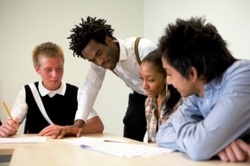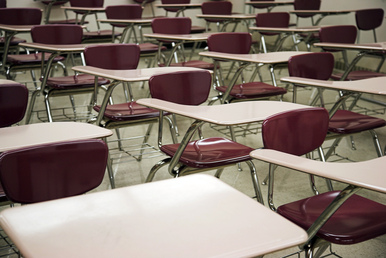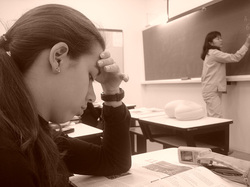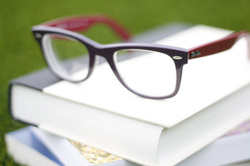Student-Teacher Relationships

Positive student-teacher relationships can help tremendously in classroom management practices. Students want to know that you care about not just their learning but them as individuals. Creating a positive environment within your classroom is a necessary step for all teachers.
We asked experienced teachers how they build positive relationships with their students. The following are some tips from them:
- Take personal interest in your students.
- Greet them every day.
- Find out students' interests and use them in your lessons.
- Show your care to your students. Be intentional in both showing and telling students you care and want them to succeed.
- Try to be involved in your students' activities (e.g. sports events, dancing,competition, choir and so on); make a point to go to one game or event for each sport or activity.
- Start each week off by allowing students to write you a quick note (e.g. Mr./Mrs. Blank, I just want you to know _______________.
- Comment on changes in students lives. Complimenting new shoes, haircut, etc., shows students you pay attention to them.
- Start the period off with a few minutes to reconnect with the class. Tell them a story or anecdote from your weekend. Ask them how the dance was. Share a joke.
Quick & Easy: The Psychology
Below is a link to a summary of work done by cognitive psychologist Robert Pianta. The summary discusses the importance of forming positive relationships with students and provides some strategies for teachers. The author believes that open communication as well as emotional and academic support that exist between students and teachers are elements that characterize positive relationships.The author also discusses how teachers can work with different academic level students. At the end, the author discusses the good outcomes of students' achievements under positive student-teacher relationships.
| forming20positive20student-teacher20relationships.pdf |
Quick & Easy: Steps to Take
Below is an easy to process handout that discusses why positive teacher-student relationships are important and how to strengthen them. The handout shows a list of steps and different resources that teachers can use to help them build positive relationships with students.
| strengthening20teaher-student20relationships.pdf |
Podcast: Teachers are Heroes

http://itunes.apple.com/us/podcast/love-logic-solutions-for-parents/id282662898
Above is a link to four free segments of a podcast on the importance of building relationships in the classroom (from Dr. Charles Fay and Jim Fay, authors of the Love & Logic books).
Video: Students Weigh In
In the above video from Alexandria City Public Schools, students reflect on the importance of good student-teacher relationships in their education
Central Relationship Concept: Teachers as Warm Demanders
http://www.learnersedgeinc.com/file/The%20Teacher%20as%20Warm%20Demander.pdf
This links to an 2008 article in the journal Education Leadership by scholars Elizabeth Bondy and Dorene D. Ross. Ross and Bondy discuss the teacher's position as a "warm demander" in the classroom, a position, they argue, that "communicates both warmth and a nonnegotiable demand for student effort and mutual respect" (54). The article is concise, research-based, and worth reading.
This links to an 2008 article in the journal Education Leadership by scholars Elizabeth Bondy and Dorene D. Ross. Ross and Bondy discuss the teacher's position as a "warm demander" in the classroom, a position, they argue, that "communicates both warmth and a nonnegotiable demand for student effort and mutual respect" (54). The article is concise, research-based, and worth reading.
Video: The 1st Day
Though this student project video contains a few oddities (setting of interview, for example), there are some helpful ideas in how to build relationships with your students. The video quotes from University of Florida professor Elizabeth Bondy and her work on classroom managment. Through interview, the video also models an activity for the first day. Ignore presentation and look for the content in this one!
More Info

For more information on Elizabeth Bondy's work, see her page on the University of Florida's website:
http://www.coe.ufl.edu/web/?pid=546
http://www.coe.ufl.edu/web/?pid=546
Video: Analyzing a Scenerio
The link below connects to a video from TeacherTV which presents a brief dramatization of a teacher-student interaction in the classroom. A panel then discusses the interaction - looking at what worked and what didn't.
http://www.youtube.com/watch?v=CjMrTFZIzzA
http://www.youtube.com/watch?v=CjMrTFZIzzA
Stories from the Classroom: Real Teachers, Real Tips
Parini, Jay (2006). “Teacher and Friend.” The Chronicle of Higher Education Volume B11.
Parini, a college professor, chronicles his experiences balancing the tension between being a teacher and a friend. Jay discusses dilemmas with grading, proper ways of being addressed and the idea of being seen as the "cool" teacher. Although the article is centered around relationships in a collegiate setting, the same principals apply to secondary classrooms. A great read for anyone concerned with how to manage personal relationships with students.
Rodriquez, L.F (2005). “Yo, mister!” Educational Leadership 62 (7). 78-80.
Rodriquez’s article provides a quick glimpse into a classroom in which a teacher stresses relationships. Though not heavily researched, Rodriquez reminds us quickly and anecdotelly how these relationships have enormous impact on content learning and how teachers’ attitudes towards students lie at the heart of these relationships. For example, after a student enters late, Rodriquez writes, “I can do nothing at that moment to change the fact that the student arrived late, but I can control how I orient and treat the student as he or she enters my classroom.” Organized, open to student input, and able to validate students’ opinions, Rodriquez gives us a quick glimpse of the methods he uses to nurture and support his students.
Brooks, V. A. (2005). "No hard feelings: finding the focus in a teacher-student function." The High School Journal 89, 54-56.
In this article, Brooks digs into some ideas that characterize the relationship between students and teachers. Establishing relationships with parents, encouraging students with realistic expectations, and attending to students needs all come into discussion in this piece. The article revolves around a variety of case studies without much detail, but the brief vignettes are more than enough to illustrate the points being discussed.
Parini, a college professor, chronicles his experiences balancing the tension between being a teacher and a friend. Jay discusses dilemmas with grading, proper ways of being addressed and the idea of being seen as the "cool" teacher. Although the article is centered around relationships in a collegiate setting, the same principals apply to secondary classrooms. A great read for anyone concerned with how to manage personal relationships with students.
Rodriquez, L.F (2005). “Yo, mister!” Educational Leadership 62 (7). 78-80.
Rodriquez’s article provides a quick glimpse into a classroom in which a teacher stresses relationships. Though not heavily researched, Rodriquez reminds us quickly and anecdotelly how these relationships have enormous impact on content learning and how teachers’ attitudes towards students lie at the heart of these relationships. For example, after a student enters late, Rodriquez writes, “I can do nothing at that moment to change the fact that the student arrived late, but I can control how I orient and treat the student as he or she enters my classroom.” Organized, open to student input, and able to validate students’ opinions, Rodriquez gives us a quick glimpse of the methods he uses to nurture and support his students.
Brooks, V. A. (2005). "No hard feelings: finding the focus in a teacher-student function." The High School Journal 89, 54-56.
In this article, Brooks digs into some ideas that characterize the relationship between students and teachers. Establishing relationships with parents, encouraging students with realistic expectations, and attending to students needs all come into discussion in this piece. The article revolves around a variety of case studies without much detail, but the brief vignettes are more than enough to illustrate the points being discussed.
An Ethnography: Literacy Practices and Student-Teacher Relationships
Moje, E. B. (1996). “’I teach students, not subjects’: Teacher-student relationships as contexts for secondary literacy.” Reading research quarterly, 31 (2), 172-95.
Interesting, but not advice-focused, this article describes how Moje conducted a two-year ethnography that looked at “how and why a veteran content teacher and her students used literacy in a first-year, high school basic chemistry class” (172). She finds that in this classroom, literacy is being used in a context of a specific teacher-student relationship. Among other points, Moje concludes that the study corroborates other research “which suggests that multiple interactions (teacher and student, student and student, teacher and administration, teacher and texts, students and texts, etc) play a part in the shaping of practice” (191).
Interesting, but not advice-focused, this article describes how Moje conducted a two-year ethnography that looked at “how and why a veteran content teacher and her students used literacy in a first-year, high school basic chemistry class” (172). She finds that in this classroom, literacy is being used in a context of a specific teacher-student relationship. Among other points, Moje concludes that the study corroborates other research “which suggests that multiple interactions (teacher and student, student and student, teacher and administration, teacher and texts, students and texts, etc) play a part in the shaping of practice” (191).
Research: Communication Behaviors in a School Setting
Frymier, A. B & Houser, M. L. (2000). “The teacher-student relationship as an interpersonal relationship.” Communication Education 49 (3), 207-19.
To examine teacher-student relationships in the classroom, Frymier and Houser look at two studies that were conducted in the university setting. Both studies take communication behaviors typically used in personal relationships to examine relationships in a school setting. Their article focuses on three main research questions: (1) what are students’ perceptions of behaviors that are important for effective teaching (specifically communication behaviors and immediacy behaviors), (2) how do students’ above perceptions relate to their motivation in the class, and (3) do male and female students’ differ in their responses to these questions.
The first study found students perceived referential skill (being clearand assisting with understanding (216)), ego support (helping students believe in themselves (216)), and conflict management important to effective teaching. The second study found a strong relationship between referential support, ego support, immediacy (a perception of closeness (209)) and students’ motivation and learning. The first study showed female students ranking more of the eight communication behaviors as important. However, there was no significant difference between the genders of how communication behaviors and immediacy relate to their motivation and learning (217). Frymier and Houser conclude, “The results of this research describe teaching as involving two primary dimensions: content and relational. Instructors must find a way to balance these two dimensions in order to successfully facilitate learning” (217).
To examine teacher-student relationships in the classroom, Frymier and Houser look at two studies that were conducted in the university setting. Both studies take communication behaviors typically used in personal relationships to examine relationships in a school setting. Their article focuses on three main research questions: (1) what are students’ perceptions of behaviors that are important for effective teaching (specifically communication behaviors and immediacy behaviors), (2) how do students’ above perceptions relate to their motivation in the class, and (3) do male and female students’ differ in their responses to these questions.
The first study found students perceived referential skill (being clearand assisting with understanding (216)), ego support (helping students believe in themselves (216)), and conflict management important to effective teaching. The second study found a strong relationship between referential support, ego support, immediacy (a perception of closeness (209)) and students’ motivation and learning. The first study showed female students ranking more of the eight communication behaviors as important. However, there was no significant difference between the genders of how communication behaviors and immediacy relate to their motivation and learning (217). Frymier and Houser conclude, “The results of this research describe teaching as involving two primary dimensions: content and relational. Instructors must find a way to balance these two dimensions in order to successfully facilitate learning” (217).



